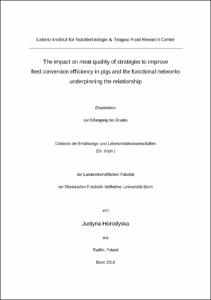Horodyska, Justyna: The impact on meat quality of strategies to improve feed conversion efficiency in pigs and the functional networks underpinning the relationship. - Bonn, 2018. - Dissertation, Rheinische Friedrich-Wilhelms-Universität Bonn.
Online-Ausgabe in bonndoc: https://nbn-resolving.org/urn:nbn:de:hbz:5n-51981
Online-Ausgabe in bonndoc: https://nbn-resolving.org/urn:nbn:de:hbz:5n-51981
@phdthesis{handle:20.500.11811/7361,
urn: https://nbn-resolving.org/urn:nbn:de:hbz:5n-51981,
author = {{Justyna Horodyska}},
title = {The impact on meat quality of strategies to improve feed conversion efficiency in pigs and the functional networks underpinning the relationship},
school = {Rheinische Friedrich-Wilhelms-Universität Bonn},
year = 2018,
month = sep,
note = {Feed efficiency (FE) is defined as a measure of efficiency in converting metabolizable energy acquired from macronutrients into body mass. The overall aims of this thesis were to identify genomic regions associated with FE in a commercial line of Maxgro boars, to evaluate the molecular and phenotypic relationship between FE and meat quality in Maxgro x (German Landrace x Large White) pigs and to investigate the molecular mechanisms contributing to differences in FE, in liver, fat and skeletal muscle tissue. Firstly, 952 boars having measures of FE traits were genotyped and used for a genome-wide association study. Most of the quantitative trait loci identified by this method were described for the first time, although some of them were located not far from previously associated genomic regions. Secondly, three metabolically important tissues, including muscle, adipose and liver were analysed. Significant differences in meat traits such as sensory profile, texture and cook loss suggest a minor impairment of meat quality from high-FE pigs. This group also exhibited leaner carcasses and greater muscle content. Ontology analysis predicted a more efficient immune defence in the muscle of high-FE pigs, which may indicate that these animals are also more efficient in conserving resources for growth. Shifts in carbohydrate conversion into glucose in FE-divergent muscle may underpin the altered post-mortem muscle pH profiles between FE groups. Moreover, differences in amino acid metabolism may influence growth in FE-divergent muscle, whereas decreased degradation of fibroblasts could impact on collagen turnover and alter tenderness of meat. Transcriptomic profiling of adipose tissue of FE-divergent pigs suggested the establishment of a dense extracellular matrix and inhibition of capillary formation might be underlying mechanisms to achieve suppressed adipogenesis. Furthermore, gene expression patterns in the liver of high-FE pigs suggested improved hepatic absorption of carbohydrates and cholesterol, and enhanced reverse cholesterol transport. The liver of high-FE pigs may be characterised by higher protein turnover and increased epithelial cell differentiation, whilst enhanced quantity of invariant natural killer T-cells and viability of natural killer cells could induce a faster and more effective hepatic response to inflammatory stimuli.},
url = {https://hdl.handle.net/20.500.11811/7361}
}
urn: https://nbn-resolving.org/urn:nbn:de:hbz:5n-51981,
author = {{Justyna Horodyska}},
title = {The impact on meat quality of strategies to improve feed conversion efficiency in pigs and the functional networks underpinning the relationship},
school = {Rheinische Friedrich-Wilhelms-Universität Bonn},
year = 2018,
month = sep,
note = {Feed efficiency (FE) is defined as a measure of efficiency in converting metabolizable energy acquired from macronutrients into body mass. The overall aims of this thesis were to identify genomic regions associated with FE in a commercial line of Maxgro boars, to evaluate the molecular and phenotypic relationship between FE and meat quality in Maxgro x (German Landrace x Large White) pigs and to investigate the molecular mechanisms contributing to differences in FE, in liver, fat and skeletal muscle tissue. Firstly, 952 boars having measures of FE traits were genotyped and used for a genome-wide association study. Most of the quantitative trait loci identified by this method were described for the first time, although some of them were located not far from previously associated genomic regions. Secondly, three metabolically important tissues, including muscle, adipose and liver were analysed. Significant differences in meat traits such as sensory profile, texture and cook loss suggest a minor impairment of meat quality from high-FE pigs. This group also exhibited leaner carcasses and greater muscle content. Ontology analysis predicted a more efficient immune defence in the muscle of high-FE pigs, which may indicate that these animals are also more efficient in conserving resources for growth. Shifts in carbohydrate conversion into glucose in FE-divergent muscle may underpin the altered post-mortem muscle pH profiles between FE groups. Moreover, differences in amino acid metabolism may influence growth in FE-divergent muscle, whereas decreased degradation of fibroblasts could impact on collagen turnover and alter tenderness of meat. Transcriptomic profiling of adipose tissue of FE-divergent pigs suggested the establishment of a dense extracellular matrix and inhibition of capillary formation might be underlying mechanisms to achieve suppressed adipogenesis. Furthermore, gene expression patterns in the liver of high-FE pigs suggested improved hepatic absorption of carbohydrates and cholesterol, and enhanced reverse cholesterol transport. The liver of high-FE pigs may be characterised by higher protein turnover and increased epithelial cell differentiation, whilst enhanced quantity of invariant natural killer T-cells and viability of natural killer cells could induce a faster and more effective hepatic response to inflammatory stimuli.},
url = {https://hdl.handle.net/20.500.11811/7361}
}






